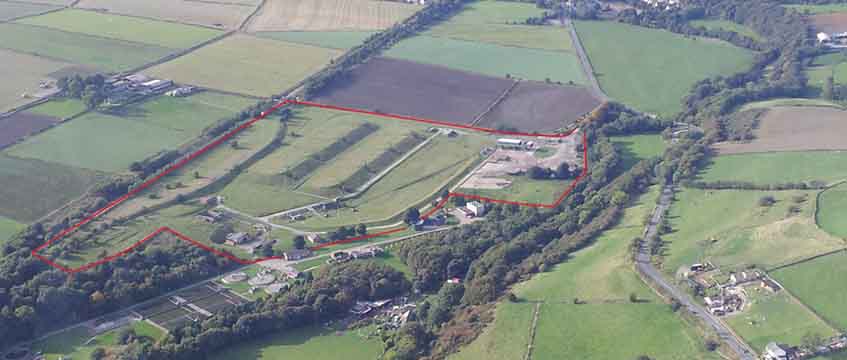Is the MoD’s estate sell-off running into planning problems?
The Penistone fuel store is probably not the jewel in the Ministry of Defence’s 1m-acre property portfolio, writes David Thame.
Three huge underground tanks and some huts on 33 acres next to the B6426 outside Barnsley, Yorkshire, will not set pulses racing.
Yet local developer Steven Green is promoting it as the Blackmoor business park (pictured above), answering a need for sub-20,000 sq ft small-box units in a district with a severe shortage of space.
The Penistone fuel store is probably not the jewel in the Ministry of Defence’s 1m-acre property portfolio, writes David Thame.
Three huge underground tanks and some huts on 33 acres next to the B6426 outside Barnsley, Yorkshire, will not set pulses racing.
Yet local developer Steven Green is promoting it as the Blackmoor business park (pictured above), answering a need for sub-20,000 sq ft small-box units in a district with a severe shortage of space.
Green is doing this despite having no financial interest in the site – no option, no ownership, not even any negotiations to acquire it.
His gamble is a big one. After all, he may not end up owning Blackmoor. “But I have to do something,” he says. “If the land isn’t allocated as employment land in the Barnsley local plan now, then when the site becomes available in four or five years time it will be too late, it will be no use, because it will be stuck in the green belt.
“I’m spending a fortune to increase the value of the MoD’s land – basically we’re doing their job for them.”
Green’s judgment on the MoD’s £1bn land sale programme is a harsh one. Is it fair? As the anniversary approaches of the latest plan to sell 35 sites, providing land for up to 55,000 homes, how is the sell-off actually going?
Missing the boat
A sampling of sites identified in the MoD’s annual Parliamentary report on defence land sales suggests the Penistone experience is not unique.
Conor Vallelly, an associate at How Planning, has kept an eye on the MoD sell-off. He says that a rule change insisting on five-yearly reviews of local plans gives the ministry another chance to get their sites included.
However, he warns they shouldn’t rely on reviews – and that missing out this time round could cause trouble.
“The MoD could be missing the boat here. The MoD’s advisers need to be more pro-active about including these sites in local plans, even if they won’t be available for five to 10 years. This is how private landowners handle longer-term prospects, on the basis that they get themselves on the local council’s radar
“Plan-making is a hard ship to turn around if you are not already on board. The MoD need to do something now.”
There is frustration at the pace of progress and fear that opportunities will be missed.
“Today they should be promoting sites in the local plan process, consulting with residents and local councils,” says one expert who did not wish to be named.
“If they got these sites into the planning system it could crystallise their value, and sharing some of that uplift with a private sector partner is what they need to do.”
The MoD says it is “focusing on rationalising its estate onto a smaller footprint that is more efficiently organised, more intensively used, with assets in better condition, and that enables it to meet the short-term targets it has been set”.
This is the aim of its estates improvement partnership with Capita. The ministry told the National Audit Office late last year that they were “undertaking a fundamental review of how its estate is managed and the role the private sector will play”.
However, the NAO has been critical of the strategy, concluding that “there is a risk that anticipated financial benefits will not be realised”. It described the plans as “extremely challenging”, and has criticised the Defence Infrastructure Organisation partnership’s (the operating arm of the MoD) with Capita, saying its performance “has not made a notable difference in transforming the DIO to better meet the needs of the commands”.
Press on regardless
It’s not all gloom – the MoD’s supporters point to major disposals like the 716-acre Waterbeach site near Cambridge, now in the hands of Urban & Civic (see panel).
The ministry says the future use of sites is a matter for their new owners, although it works closely with local authorities and other interested parties to consider the best possible future uses for sites.
An MoD spokesperson told EG: “Our aim is to generate money to re-invest in our armed forces by selling land we don’t need for new homes that we do. The MoD adheres to HM Treasury guidelines which set out the timeframe for selling sites which have been announced for disposal. Over the past seven years we have released land with the capacity for almost 40,000 houses.”
Urban & Civic development director Tim Leathes believes the ministry is getting it right.
“Of course you want to get your project lined up for inclusion in the local plan, and clearly there are good times and bad times for doing that,” he says. “But there are so many issues for the MoD to consider, and they won’t risk promoting a site through the local plan until they are sure. Which of course is a big challenge for both local authorities and the MoD.”
Leathes says it is possible to press on with major schemes regardless, as they did at the Alconbury site, where 5,000 homes and 3m sq ft of commercial space is planned.
“This is the kind of brownfield sustainable development the National Planning Policy Framework encourages, so you can move forward even if, at first, you are outside the local plan process,” he says.
Even so, it doesn’t negate the frustration felt by some with the slow progress. “We’re trapped on a cycle of announcements by ministers, which then run into the ground, then five years later it starts again,” one observer told EG.
“We had another of these announcements late last year, it was almost exactly the same as the one they gave five years ago, and here we still are, waiting.”
David Thame
Big success
Waterbeach Barracks, Cambridgeshire, is among the largest MoD sites to be redeveloped.
The 716-acre project could see Waterbeach become a new Fenland town with 6,500 new homes, 177,000 sq ft of retail and four schools, all just a few miles from the Cambridge science park.
Urban & Civic was selected as development partner for the Defence Infrastructure Organisation in September 2014, a year after the Royal Engineers left the site.
The site was included in South Cambridgeshire’s 2014 local plan thanks to the efforts of a neighbouring landowner. In February 2017 Urban & Civic applied for outline planning consent.











